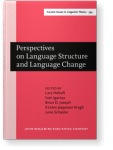Approaching the typology and diachrony of morphological reversals
Inverse marking in inflectional morphology represents a particular type of mismatch between morphological form and syntactic or semantic function. This kind of morpheme interchange has been found in several languages thus far, but it is not usually included in morphological studies. There have been significant advances in recent times regarding the synchronic description and theoretical assessment of morphological reversals, but the diachronic treatment of this set of phenomena is at most in its incipient stage. Despite the overall scarcity of historical data on the rise of inverse marking patterns, there is, nonetheless, a certain amount of evidence that allows for an understanding of the dynamics of morphological polarity in a diachronic perspective. This paper first provides a revised typology of morphological reversals and then examines two processes of change leading to the appearance of inverse encoding patterns in two inflectional systems (declensional paradigms in Old French and the feature of number in Upper Sorbian). Although differing in important respects (such as the extent to which they can be considered reversals), both innovations demonstrate some of the motives, mechanisms, and functional principles underlying the emergence of inverse marking patterns in inflectional morphology.
Article outline
- 1.Introduction
- 2.Typology of inverted morphological relations
- 2.1Types of inversion
- 2.2Full morphological reversals
- 2.3Partial morphological reversals
- 2.4Morphological quasi-reversals
- 2.5Summary
- 3.Lessons from diachrony: Accounting for the rise of reversals
- 3.1Old French declensional classes
- 3.2The expression of paral reference in Upper Sorbian
- 4.The economy of marker inversion and the role of morphological ambiguity
- 5.Conclusion
-
Notes
-
References
